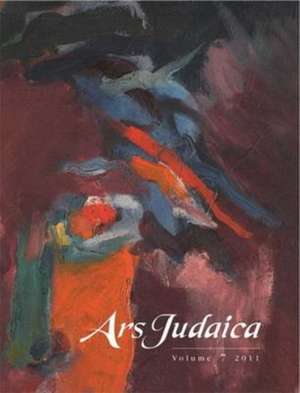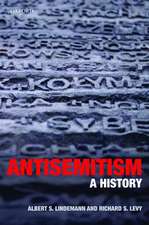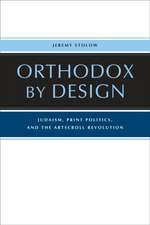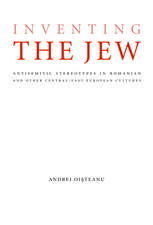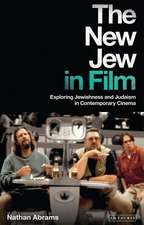Ars Judaica: The Bar–Ilan Journal of Jewish Art, Volume 7
Autor Bracha Yaniv, Mirjam Rajner, Ilia Rodoven Limba Engleză Paperback – 28 sep 2011
and folklore. As such it is a valuable resource for art historians, collectors, curators, and all those interested in the visual arts. The study of Jewish art frequently raises questions relating to Jewish survival and Jewish identity. These issues have always been of relevance throughout the Jewish
diaspora, and as is evident from the articles in this volume they continue to concern Jewish artists to this day. The opening article, 'Illuminations of Kol Nidrei in Two Ashkenazi Mahzorim' by Sara Offenberg, deals with the hidden meanings expressed by groups of animals depicted in two medieval
Ashkenazi prayer books for the Day of Atonement. By using allegorical animals in this way the Jews of the thirteenth and fourteenth centuries could safely express their fear of the hostile Christian society in which they lived, as well as their trust in God and belief in redemption. A surprising link between the Middle Ages and modern times is made by Rachel Singer's article, 'Maurice Sendak's Where the Wild Things Are: An Exploration of the Personal and the Collective'. Published in 1963, this classic children's book, written and illustrated by the son of a Jewish immigrant
family in Brooklyn, is far removed, both chronologically and geographically, from the Ashkenazi Middle Ages. In her study, however, Singer prises out hidden sources of antisemitic perceptions rooted in medieval Christian Europe. This leads us to the volume's third article, 'The Return of the
Wandering Jew(s) in Samuel Hirszenberg's Art' by Richard I. Cohen and Mirjam Rajner. The motif of the wandering Jew, a negative and frightening figure, is rooted in the late Middle Ages: it made its first appearance in Christian art, in printed books which disseminated the Christian legend all over
Europe. In the nineteenth century, Jewish artists engaging with the image of the wandering Jew endowed it with new interpretations and presentations. One of these is revealed by the authors as they focus on the painting The Wandering Jew, created in 1899 by the Polish Jewish artist Samuel
Hirszenberg. As is well known, emancipation and the Jewish national awakening in late nineteenth-century Europe were accompanied by diverse artistic activities. These included the establishment of Jewish societies promoting Jewish art and artists, exhibitions, documentation, and research. Among the most
impressive efforts were the activities of Jewish artists in interwar Poland, recorded in contemporary local newspapers and periodicals. As these were published in Polish and Yiddish they weren't accessible to the English-speaking reader, something that is now rectified by Renata Piatkowska in 'A
Sense of Togetherness: The Jewish Society for the Encouragement of the Fine Arts in Warsaw (1923 - 1939)'. Based on primary sources, the article introduces us to the flourishing artistic life which was cruelly destroyed in the Holocaust. Another result of Jewish national awakening, in this case in
the medium of photography, is presented in 'Modernity as Anti-Nostalgia: The Photographic Books of Tim Gidal and Moshe Vorobeichic and the Eastern European Shtetl', by Rose-Carol Washton Long. This article examines how Zionist ideas led two assimilated German-trained photographers to develop variant thematic and stylistic portrayals of eastern European shtetls in their photobooks, published in 1931 and 1932. Their volumes are neither romantic nor nostalgic, but instead convey a vibrant
vision of modernity. While the first five articles discuss issues of identity encountered by Jewish individuals or groups, the next contribution focuses on a 'Jewish identity' that was imposed by a colonial administration. Dominique Jarrasse's 'Orientalism, Colonialism, and Jewish Identity in the
Synagogues of North Africa under French Domination' fills the gaps in our knowledge of synagogue architecture in Tunisia and Algiers in the modern era in general, and about colonial Orientalism in particular. Covert Jewish identity is revealed by Milly Heyd in 'Hans Richter: Universalism vis-a-vis
Particularism'. This is the third part of her study of the place of the hidden Jew in the Dada avant-garde, one part of which is published in volume 1 of Ars Judaica. The focus in the present piece is on Hans Richter's art in the context of Man Ray, Tristan Tzara, and others who were born to Jewish families but opted for universalism rather than particularism in their art. The Special Item in this year's volume is devoted to a painting by Moritz Oppenheim that
was long thought to be lost. 'Of Provenance and Providence: On the Reappearance of David Playing the Harp for Saul by Moritz Oppenheim', by Susan Nashman Fraiman, raises some new and interesting questions about Oppenheim's early work and patrons. The study of this painting reveals a conscious effort
to incorporate Jewish source material into his work, an important aspect of his corpus which has previously been neglected.
Preț: 487.27 lei
Nou
Puncte Express: 731
Preț estimativ în valută:
93.25€ • 96.100$ • 76.98£
93.25€ • 96.100$ • 76.98£
Carte disponibilă
Livrare economică 24 martie-07 aprilie
Preluare comenzi: 021 569.72.76
Specificații
ISBN-13: 9781906764333
ISBN-10: 1906764336
Pagini: 160
Dimensiuni: 220 x 278 x 16 mm
Greutate: 0.84 kg
Ediția:New.
Editura: LUP – Littman Library
ISBN-10: 1906764336
Pagini: 160
Dimensiuni: 220 x 278 x 16 mm
Greutate: 0.84 kg
Ediția:New.
Editura: LUP – Littman Library
Cuprins
Editor's Note BRACHA YANIV Illuminations of Kol Nidrei in Two Ashkenazi Mahzorim SARA OFFENBERG Maurice Sendak's Where the Wild Things Are: An Explanation of the Personal and the Collective RACHEL SINGER The Return of the Wandering Jew(s) RICHARD I. COHEN and MIRJAM RAJNER The Sense of Togetherness: The Jewish Society for the Encouragement of the Fine Arts in Warsaw (1923 - 1939) RENATA PIATKOWSKA Modernity as Anti-Nostalgia: The Photographic Books of Tim Gidal and Moshe Vorobeichic and the Eastern European Shtetl ROSE-CAROL WASHTON LONG Orientalism, Colonialism, and Jewish Identity in the Synagogues of North Africa under French Domination DOMINIQUE JARRASSE Hans Richter: Universalism vis-a-vis Particularism MILLY HEYD Special Item Of Provenance and Providence: On the Reappearance of David Playing the Harp for Saul by Moritz Oppenheim SUSAN NASHMAN FRAIMAN Book Reviews Discovering the Magic of Yiddishkayt Futur anterieur: L'avant-garde et le livre yiddish (1914 - 1939), catalogue, ed. Nathalie Hazan- Brunet with Ada Ackerman BER (BORIS) KOTLERMAN Felix Lembersky: The Artist Uncovered Yelena Lembersky (ed), Felix Lembersky (1913 - 1970): Paintings and Drawings ORI Z. SOLTES Books and Catalogues Received ELISHEVA REVEL-NEHER, AVIVA CARMI LEVINE In Memoriam Kazimierz Maciej Piechotka (1919 - 2010) by Samuel D. Gruber Abbreviations Contributors to this Issue Submission and Style Guidelines
